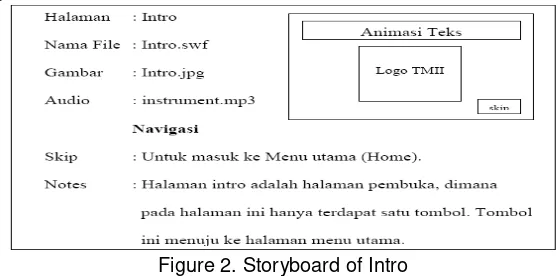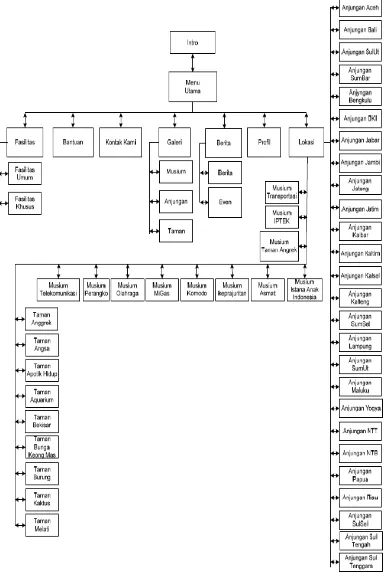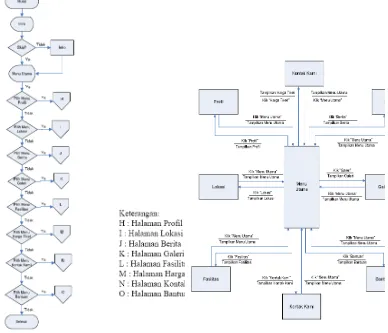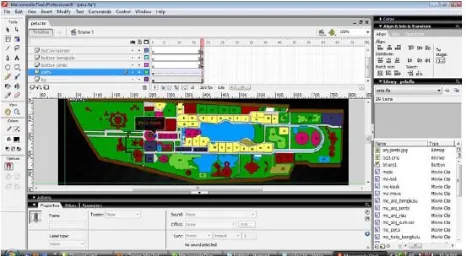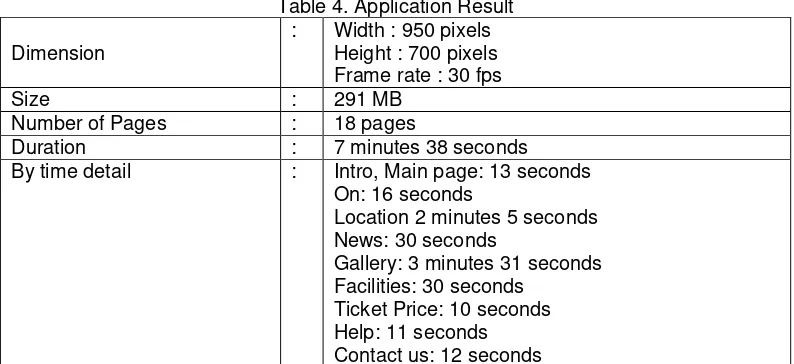254
Information Kiosk Application Development at
Taman Mini Indonesia Indah Jakarta
Qurrotul Aini, Eko Syamsuddin H., Ahmad Zaky Syarif Hidayatullah State Islamic University Jakarta Jl. Ir. H. Juanda 95, Tel : 0217493547 Fax : 0217493315
e-mail: [email protected]
Abstrak
Taman Mini Indonesia Indah (TMII) adalah tempat pariwisata di Jakarta yang memiliki area 160 hektar dan terdapat 26 anjungan (rumah adat), 13 museum, 10 taman wisata, fasilitas umum dan khusus yang letaknya berjauhan. Pengunjung sangat memerlukan layanan informasi yang dapat membantu mencari lokasi, informasi dan fasilitas yang disediakan. Peneliti mengusulkan aplikasi kios informasi sebagai solusi alternatif bagi pengunjung TMII sebagai alat bantu mendapatkan informasi yang diperlukan. Pengembangan aplikasi menggunakan metode pengembangan aplikasi multimedia Luther yang terdiri atas konsep, perancangan, pengumpulan bahan, pembuatan, pengujian dan distribusi. Aplikasi meliputi sembilan rancangan interface, memiliki spesifikasi dimensi 950 x 700 pixel, 30 fps, kapasitas ukuran 291 MB, 18 halaman, durasi 7 menit 38 detik. Berdasarkan evaluasi berupa kuesioner terhadap 20 pengunjung TMII, dapat disimpulkan bahwa 80% pengunjung menyatakan aplikasi ini menarik, 80% menyatakan aplikasi mudah digunakan, 90% membantu pengunjung dalam mencari lokasi yang terdapat di TMII dan 80% menyatakan informasi yang tersedia sudah jelas.
Kata kunci : kios informasi, database, multimedia, Taman Mini Indonesia Indah, Luther.
Abstract
Taman Mini Indonesia Indah (TMII) is a tourism site in Jakarta, which has area of 160 hectares and there are 26 traditional houses, 13 museums, 10 tourist parks, public and special facilities which are located far apart. Visitors needed information services that could help find the location, information and the facilities. Researchers proposed information kiosk applications as an alternative solution tool to help find the necessary information. The application development used multimedia development refers to Luther’s method; consist of concept, design, gathering materials, manufacture, testing, and distribution. The application interface includes nine designs, with dimension 950 x 700 pixels, 30 fps, capacity size of 291 MB, 18 pages, and duration of application 7 minutes 38 seconds. Based on questionnaire of 20 visitors, it could be concluded that the application was interested (80%), easy to use (80%), the information provided was clear (80%), and could assisted visitors to find the locations (90%).
Keywords: information kiosks, database, multimedia, Taman Mini Indonesia Indah, Luther.
1. Introduction
Taman Mini Indonesia Indah (TMII) is a tourism site which has an area of 160 hectares comprising 26 traditional houses from various provinces in Indonesia and the distance is far apart from one another. In addition, there are 13 history museums and 10 tourism parks. During this time, visitors get the information about pavilion and facilities in TMII from brochures distributed and the signpost. It is difficult for visitors because they have to memorize the entire site. Therefore, visitors of TMII really need a very clear and precise information service, which can facilitate to search for a location, information about the tours in TMII, TMII announcement of the new facility in TMII.
255
facilitated visitors to find out animal location at Ragunan Zoo [2]. Refer to [3], information kiosks allow visitors to obtain information about existing facilities at the shopping centers.
Based on previous studies, researcher proposed an information kiosk application multimedia-based used development method by Arc C. Luther. The presentation of the information multimedia to TMII visitors, become more interesting and interactive.
2. Research Method
The Information Kiosk application, conducted multimedia development stages according to Luther [4] where the development of multimedia application is based on six stages, namely concept, design, material collecting,assembly, testing and distribution as in Figure 1.
Figure 1. Multimedia Application Development Cycle by Luther
The information kiosk application development stages as follows: [4] a. Concept
The aim of the project is determined in this phase, including identification of audiences, applications, application purpose, and general specifications. The output of concept stage usually is a narrative writing to express the project objectives.
b. Design
The design stage is to make a detailed specification of the application to be made, as well as the style and material requirements for applications. The design included storyboard, navigation structure, application flowchart, state transition diagram, database specification, and user interface.
c. Material Collecting
At the material collecting stage made the collection of materials such as layout, information about the Taman Mini Indonesia Indah, image, audio, and video. The materials obtained from internet, observation and interview with Head of Information Center TMII. d. Assembly
The assembly stage is the stage where the projection of the perspective plan and all the multimedia objects are made. The stage made the coding that has been predetermined in design stage, which used Macromedia Flash [5], [6], Macromedia Freehand, Macromedia Dreamweaver [7], and XAMPP [8], [9], [10], [11].
e. Testing
The testingstage is the testing of programs that have been completed. The testing process is focused on the logic in a program of software to ensure that all program codes have been tested
f. Distribution
At this stage, conducted implementation and evaluation of multimedia applications. The stages of implementation and evaluation researcher did were:
256
3. Explain the display. 4. Application evaluation.
3. Analysis and Results
The analysis and results for application development started with concept description in kiosk application development.
3.1 Concept Description
The application of multimedia-based information kiosks at TMII was the kind of interactive applications used by visitors as reliable information. Visitors could found the location of traditional houses, public facilities and playgrounds efficiently. The following Table 1 described the concept description of information kiosks application.
Table 1. Description Outline of Concept Information Kiosk Application 1. Title: Information Kiosk Application Development at TMII 2. Type of
Application:
Interactive information media in an information kiosk
3. Audience: Visitors and Manager of TMII
4. Picture: Using files with jpg, png, tga, and swf format with Adobe Photoshop CS2, Macromedia FreeHand and Macromedia Flash Professional 8 software
5. Audio: Using instrumental music with MP3 file format and some from the internet
6. Animation: Animation on the text and images that created itself using Macromedia Flash
7. Interactive: Using the navigation buttons, animations, and voice media use on the application in the form of narrative
3.2. Design
At the design stage, the researchers created storyboard depicting the appearance of each scene. Because the application made was not simple, then it needed navigation structures that can be used to define links from one to another page.
a. Storyboard
The storyboard draft researcher made in the design of multimedia based information kiosk application at TMII comprised 10 storyboards. One example of storyboards shown in Figure 2.
Figure 2. Storyboard of Intro
b. Navigation Structure: Navigation structure showed a plot on the information kiosk application (Figure 3).
c. Flowchart
Researchers distinguished flowchart from the admin and user side. The flowchart from admin side included comprises Admin Home Page, Profile, News, Gallery, Contact Us, and Help. Meanwhile the flowchart from the user covered of Main Menu (Figure 4), Location, Profile, News, Gallery, Facilities, Contact Us, and Help.
257
There were nine STDs On the multimedia-based information kiosk application at Taman Mini Indonesia Indah Jakarta consists of 9 (nine) STDs one is as Figure 4.17 STD Home Page. For further STD can be seen in Appendix 5 which consists of: STD profiles, STD news, STD ticket price, STD Gallery, STD Facility, STD Location, STD Contact Us, Help STD.
258
Figure 4. Flowchart of Main Menu Figure 5. STD of Main Menu
e. Database Specification
In database specification for information kiosk application consists of seven tables. One of the tables is Admin table.
1. Admin Table Table Name: login File Type: Master Primary Key: username Foreign Key: -
Table 2. Admin
Field Name Data Type Size Description username Varchar 35 Username admin password Varchar 35 Password admin
f. User Interface
In application, the researchers simplified every existing page by minimizing the use of buttons, it meant for facilitate the visitors to able operate the computers. There were two interface designs namely the interface design for users and for admin page.
3.3. Material Collecting
259
Figure 6. User’s Interface Design on Main Menu
Figure 7. TMII Map Tracing Result
3.4. Assembly
On the intro page of images obtained from Taman Mini Indonesia Indah and the Internet which are then processed by using motion tween-effect with the details of 14 layers, 562 frames at 24 fps (frame per second) on Macromedia Flash Professional 8 (Figure 8). In the database of this information kiosk application there are eight tables, while for the making of its database is using PhpMyAdmin (Figure 9). In the process of making animated signpost the location of the traditional houses, museum and recreation parks visualized by dotted lines and red dots image on the location page using the effect motion tween so it displayed an interactive animation illustrated in Figure 10, it allowed visitors to find and locate traditional houses, museum, and park.
260
Figure 10. Making Animation with Macromedia Flash 8
3.5. Testing
At this stage, the testing of applications which have been made is conducted. The testing of information kiosk application is by using black-box testing.
Table 3. Black-Box Testing of Information Kiosk Application from User side No. Drafting Process Result Expected Result Description
1. Click 'Main Menu' Display the opening page of Information Kiosk Application
Ok Home Page of Information Kiosk Application
2. Click 'Profile' Displaythe profile Ok page of a brief history of Taman Mini Indonesia Indah
3. Click on 'Location' Display the location Ok Location page of Taman Mini Indonesia Indah 4. Click 'News' Displaying the “News” Ok information page to select
the news and events at TMII
5. Click on 'Gallery' Displaying Ok profiles page
6. Click on 'Facilities' Displaying facilities Ok Facilities page available at Taman Mini Indonesia Indah
7. Click on 'Tickets' Displaying ticket price Ok Fares page
8. Click on 'Help' Displaying help Ok help page of Information Kiosk Application usage 9. Click on 'Contact Us' Displaying contact us Ok page Contact of TMII
3.6. Distribution
The program will run properly with suggested requirements, consist of:
a. Hardware Specifications
The following are minimum specifications used for testing the application, namely:
AMD Sempron 1:04 GHz.
Memory 512 MB of RAM.
Monitor with a resolution of 1024 x 768 pixels.
Keyboard and mouse.
Sound card and speaker active.
The remaining capacity hard disk of 150 MB.
b. Software Specifications
The software required by users to run applications of information kiosks were Operating System Microsoft Windows XP or Vista, Apache, PHP, MySQL, Browser (Mozilla Firefox recommended), and FlashPlayer 9.
c. Explanation of Application Display
261
Location 2 minutes 5 seconds News: 30 seconds
Gallery: 3 minutes 31 seconds Facilities: 30 seconds
Ticket Price: 10 seconds Help: 11 seconds Contact us: 12 seconds
d. Evaluation
The evaluation conducted after the program testing, by giving 20 questionnaires to visitors. The results of evaluation questionnaire that could be concluded:
The application is interesting in terms of its look and animation (80%).
The application is easy to use (user friendly) (80%).
The information presented by this application is quite clear (80%).
The application can assist visitors in finding the locations contained in the area of Taman Mini Indonesia Indah (90%).
4. Conclusion
1. The information kiosks application could help visitors in search for locations of traditional houses, museums, parks, and public facilities which were located at TMII. 2. Based on the results of questionnaires which have been distributed to visitors of Taman Mini Indonesia Indah that with the multimedia, the display of information kiosk application was interesting and easy to use.
References
[1] Nur Ulfah Sam. Pengembangan Aplikasi Pembelajaran Materi Pengolahan Citra dengan Menggunakan Teknik Konvolusi Berbasis Multimedia (Studi Kasus: Program Studi Teknik Informatika Fakultas Sains dan Teknologi UIN Syarif Hidayatullah Jakarta). Undergraduate Thesis. Jakarta: FST UIN Syarif Hidayatullah; 2010.
[2] Haris Mustamsikin. Rancang Bangun Aplikasi Kios Informasi Berbasis Multimedia pada Taman Margasatwa Ragunan Pasar Minggu Jakarta Selatan. Undergraduate Thesis. Jakarta: FST UIN Syarif Hidayatullah; 2009.
[3] Fakhrurroji. Analisis dan Perancangan Kios Informasi Berbasiskan Multimedia pada Mal Grage Cirebon. Undergraduate Thesis. Jakarta: FST UIN Syarif Hidayatullah; 2009.
[4] Ariesto Hadi Sutopo. Analisis dan Desain Berorientasi Objek. Yogyakarta: J&J Learning, 2002. [5] Ariesto Hadi Sutopo. Multimedia Interaktif Dengan Flash. Jakarta: Penerbit Graha Ilmu. 2003. [6] Chandra. Flash Professional 8 Untuk Orang Awam. Palembang: Maxikom. 2006.
[7] M. Suyanto. Multimedia Alat Untuk Meningkatkan Keunggulan Bersaing. Yogyakarta: ANDI. 2003.
[8] Betha Sidik. Pemrograman Web dengan PHP. Bandung: Informatika. 2004.
[9] Madcoms. Aplikasi Program PHP & MySQL untuk membuat website Interaktif. Yogyakarta: ANDI. 2004.
[10] Janner Simarmata dan Imam Prayudi. Basis Data. Yogyakarta: Penerbit ANDI. 2006.
